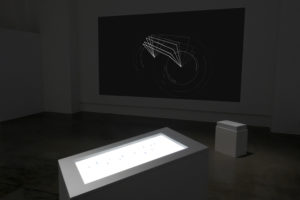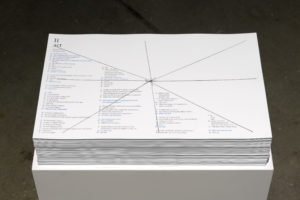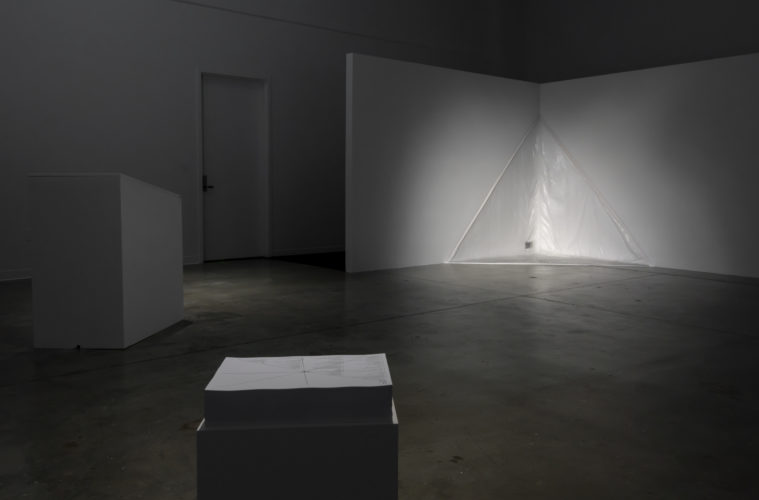The role of an art object is a tenacious and assumptive role. What it does or does not do can be decided by artist or viewer. Its singular life and role in our world is complex, always changing and never stationary; it changes as seasons changes, as views shift and as history moves forward. Language acts similarly; meanings of words and sentences change in different contexts, over time and when spoken or written by different people. Ella de Búrca’s latest exhibition – and first U.S. solo exhibition – “Flat As The Tongue Lies” at the University of California, Irvine Room Gallery, explores these fascinating complexities in language through sound, text, kinetic sculpture and video.
Walking into the Room Gallery on UCI’s campus, you emerge into total darkness with whispering sounds leading you down a corridor. As your eyes adjust, you notice small amounts of light around a corner, and another small amount of light on a shelf directly next to the entrance, lighting some small booklets associated with the exhibition. “SHH, SHH, SHH, SHE, SHE, SHH, SHAME,” you hear. As you walk down the corridor, the sounds change, using alliteration, textured consonants and simplified word-fragment sounds from a woman’s mouth. “Is this how you read me?” she asks. “Read us?”
The sensory experience from first entering the gallery is enticing and curious, and as you turn the corner of the corridor and enter the larger space of the Room Gallery, there are sparsely placed works in a variety of mediums to quench that curiosity. Led by intuitive exhibition design, you approach a tilted screen on what looks like a podium. Recalling an illuminated manuscript, this text video has sparse words in bold blue in a poetic pattern down the screen. After only a few moments, more text begins to appear, creating sentences and a larger story.
Just as quickly as they appeared, they fade away and come back with different lines of text. The bolded words remain unchanged, “Line, word, work, draw, division, output, form, style, one, decay, labouring, part.” By themselves, these words mean nothing, but when combined they create meaning. This piece, Act I (When The Flat Fell Down), seems to explore the creative process itself, with all its relative beauty, chaos and anxiety. Like the creative process, a simple idea, line or word appears, then the creator must flesh the rest of the piece out, filling in gaps and holes. The creator must consider presentation of the work to the world and make amendments accordingly, and then it disappears as the audience receives it, uncontrolled and unchaperoned.

Photos courtesy of UNIVERSITY ART GALLERY, UC IRVINE © 2018. PHOTO: JEFF MCLANE
In the midst of digesting Act I, the senses begin awakening with the sounds and visual movements in the other corners of the gallery space. With the sound of wind or a kind of breath in the darkness, you are beckoned to turn around and notice the slow breathing, plastic pyramid living quietly in the corner – breathing deeply, inflating and deflating – like a stranger politely waiting for your attention. Thinking about this whole show as a play (with “acts”), makes this kinetic sculptural piece, Stage, seem like an actor or the artist herself, directing your awareness to her absence, but focusing your attention on her breath, her life, her words. All the while the voices from the corridor continue to project textured words and sounds.
The largest visual work in this exhibition is projected onto the wall – a minimalistic stop-action animation using only lines. The use of black and white colors only is a calming visual addition to this project, but not very visually compelling. In front of the projection is a low pedestal with a huge stack of large papers on it, each identical. Upon closer examination, it is a play titled Act II (Mouthing).
This one-page play has the backwards mirror reflection of the exact opposite visual on the back of the paper, as if the paper is see-through, but it is not. This short play is very reminiscent of a singular Samuel Beckett play. It is a strange conversation between two characters, X and Y, with a narrator, O, who seems to come in and out of being a part of the scene. They discuss etymology, the older meanings of words, and how they’ve changed over time. Like the meanings of the words “sky” and “cloud,” the narrator’s role seems to shift and change throughout time. This play is playing with our perception of language, meaning and of the artifice of the art object.

Photos courtesy of UNIVERSITY ART GALLERY, UC IRVINE © 2018. PHOTO: JEFF MCLANE
De Búrca seems to have created a three-part play with this installation and exhibition. Each act of this production gives us more information about the larger intention and mission of this project. A more complete and compelling understanding of this exhibition only seems to come to the surface after viewing every act, similarly to how words are attributed meaning after they are spoken in statements or sentences.
In the accompanying booklet of the same name, “Flat As The Tongues Lies,” we are provided with further details related to the research, concepts and goals of the exhibition and artist, as told through the words of the Curator, Allyson Unzicker. The booklet references de Búrca’s work with regard to Samuel Beckett, Hélène Cixous, Sigmund Freud and Roland Barthes.
In the current political climate of the American #MeToo movement and the Irish #IBelieveHer movement, women have utilized different avenues of writing and speaking to call out abuse and harassment in an effort to expand women’s rights all over the world. Ireland-born de Búrca finds interesting commonalities in the shared use of text and voice to gain momentum and build bridges, while also finding pathways that others have used to turn around the same words used to empower women to disparage them.
De Búrca’s “Flat As The Tongues Lies” is a sensory experience that is playful and thought-provoking while engaging in timeless cultural queries of language, meaning and text, it also seems to touch on the longstanding struggle of a female perspective.
“Flat As The Tongues Lies” is on view through December 15, 2018 at Room Gallery, Claire Trevor School of the Arts, University of California, Irvine, 4000 Mesa Rd., Irvine
Advertising disclosure: We may receive compensation for some of the links in our stories. Thank you for supporting Irvine Weekly and our advertisers.

